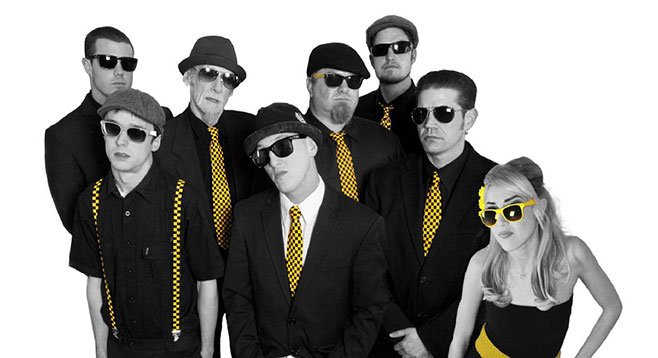 Facebook
Facebook
 X
X
 Instagram
Instagram
 TikTok
TikTok
 Youtube
Youtube

Oceanside Sound System: not a stereo repair shop. The North County band started in 2009 as a four-piece with guitarist Ben Blessing and drummer Sid Sloth from Irieside, a jam-rock-reggae-hip-hop band, and a singer named Skillet who’d made his name in an antagonistic punk unit called Wanted Dead. The result was a ground-pounding fusion of ska and punk under one roof. There was a ready skankpit waiting for the O.S.S. hybrid sound, and soon the band’s membership ballooned to nine members. They earned stage time with majors such as the Toasters and Voodoo Glow Skulls, the Aggrolites, and another local outfit that went large called Buck-O-Nine.
4th Wave, the title of Oceanside Sound System’s newest CD, is a reference to ska’s ancestry: First Wave happened in the Jamaica of the 1960s. Second Wave launched two decades later in the U.K., where it was also known as 2 Tone, and the Third Wave happened in the ’90s. The epicenter of Third Wave was in Orange County. This year, the O.S.S. lineup has slimmed down to five members, which for the most part is a driving rhythm section and a well-mannered sax player.
Nobody knows where the word ska came from, but the music was invented in Jamaica maybe 60 years ago, the roots of ska being largely American, what with jazz and R&B conventions mixed with strains of Calypso. The ska bottom end is a propulsive four-on-the-floor beat with accents on the upbeats that generally land between the one and two, two and three, and three and four. In the years before reggae came to pass, islanders were good with ska. Brits couldn’t get enough of it, and later, skinheads would turn ska into a bloody contact sport. I never understood the need for violence, but so be it. Blood and broken bones served some kind of weird purpose back then, but that’s over. Consider it safe to skank.


Oceanside Sound System: not a stereo repair shop. The North County band started in 2009 as a four-piece with guitarist Ben Blessing and drummer Sid Sloth from Irieside, a jam-rock-reggae-hip-hop band, and a singer named Skillet who’d made his name in an antagonistic punk unit called Wanted Dead. The result was a ground-pounding fusion of ska and punk under one roof. There was a ready skankpit waiting for the O.S.S. hybrid sound, and soon the band’s membership ballooned to nine members. They earned stage time with majors such as the Toasters and Voodoo Glow Skulls, the Aggrolites, and another local outfit that went large called Buck-O-Nine.
4th Wave, the title of Oceanside Sound System’s newest CD, is a reference to ska’s ancestry: First Wave happened in the Jamaica of the 1960s. Second Wave launched two decades later in the U.K., where it was also known as 2 Tone, and the Third Wave happened in the ’90s. The epicenter of Third Wave was in Orange County. This year, the O.S.S. lineup has slimmed down to five members, which for the most part is a driving rhythm section and a well-mannered sax player.
Nobody knows where the word ska came from, but the music was invented in Jamaica maybe 60 years ago, the roots of ska being largely American, what with jazz and R&B conventions mixed with strains of Calypso. The ska bottom end is a propulsive four-on-the-floor beat with accents on the upbeats that generally land between the one and two, two and three, and three and four. In the years before reggae came to pass, islanders were good with ska. Brits couldn’t get enough of it, and later, skinheads would turn ska into a bloody contact sport. I never understood the need for violence, but so be it. Blood and broken bones served some kind of weird purpose back then, but that’s over. Consider it safe to skank.
Comments